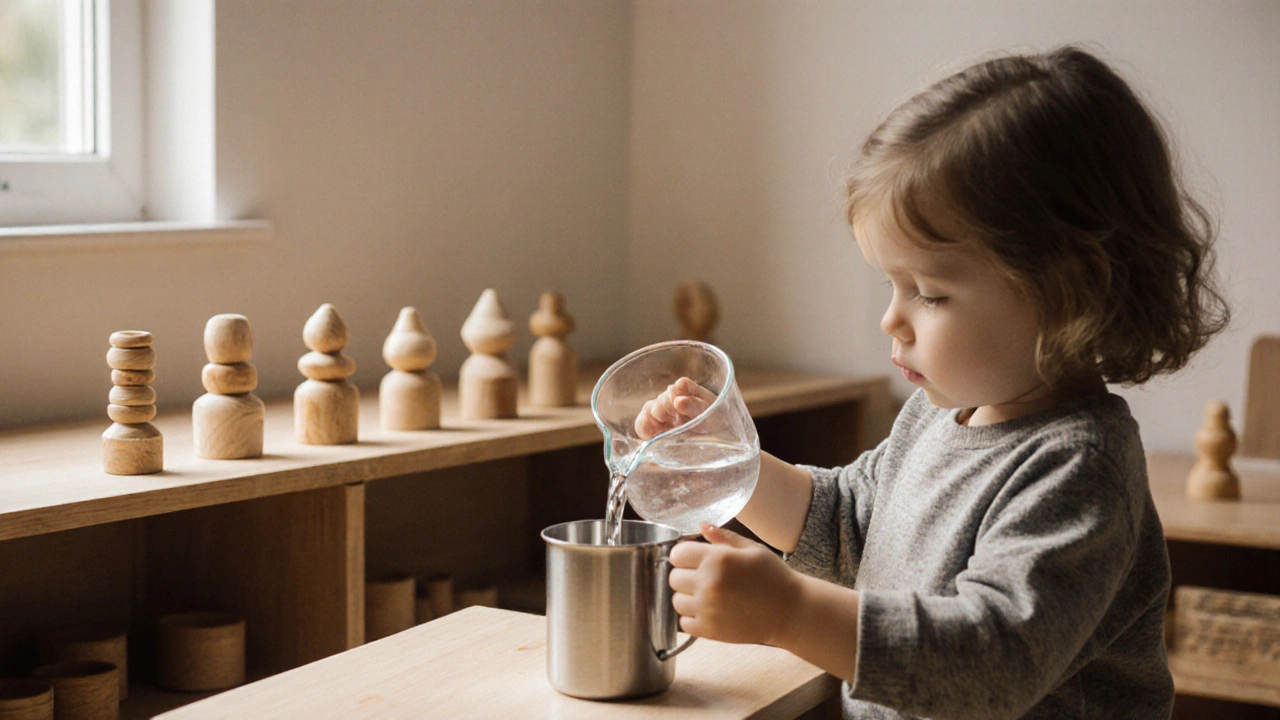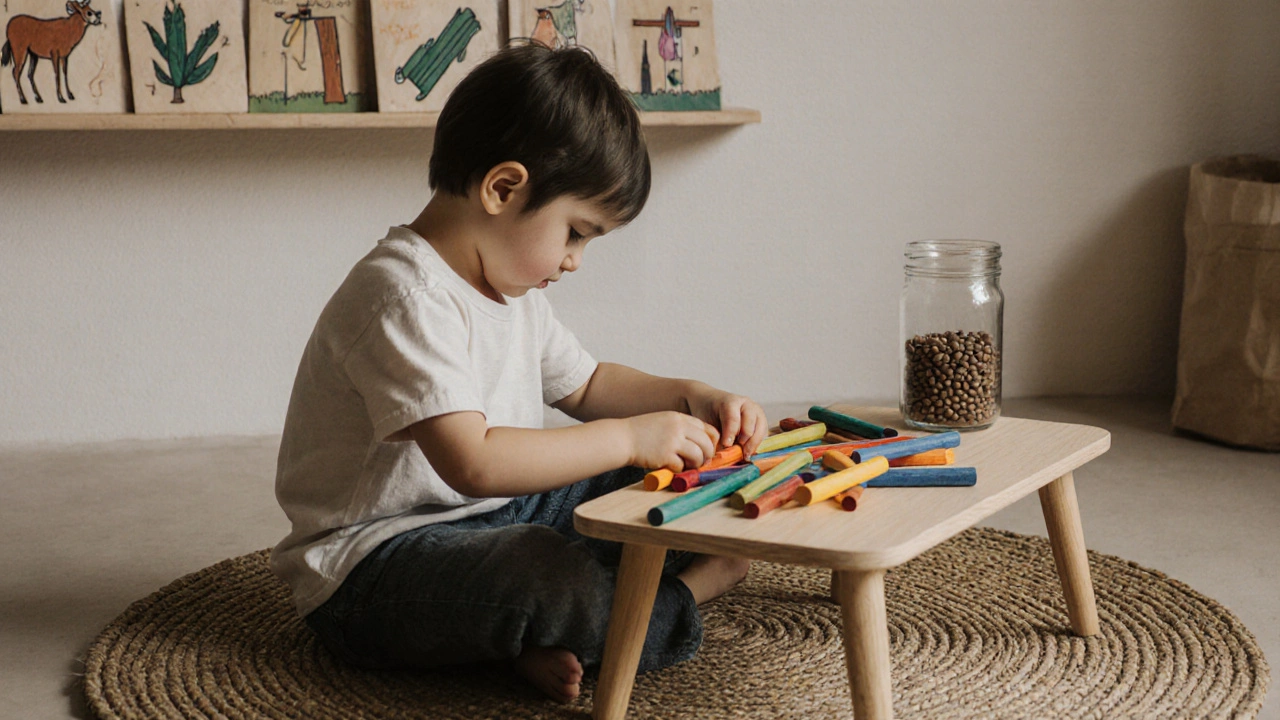Why Montessori Education Rejects Plastic Toys

Montessori Toy Comparison Tool
Which Toy Better Supports Development?
Learning Value
Sensory Engagement
Sustainability
Focus & Attention
Real-World Connection
Based on Montessori principles from the article: plastic toys often provide passive stimulation without teaching cause-effect relationships, while natural materials promote hands-on learning and environmental awareness.
Walk into a Montessori classroom, and you’ll notice something missing: no bright, blinking, battery-powered toys. Instead, you’ll see wooden blocks, woven baskets, glass pitchers, and metal puzzles. It’s not just a style choice-it’s a philosophy. Montessori education doesn’t just prefer natural materials over plastic; it actively avoids plastic toys because they conflict with how children truly learn.
Plastic toys don’t teach real cause and effect
Think about the toy you’ve seen a hundred times-a plastic dinosaur that roars when you squeeze its belly. It’s loud. It’s flashy. It’s designed to grab attention. But what does it teach? Not much. The child doesn’t need to figure out how to make the sound happen. It just does. There’s no effort, no problem-solving, no connection between action and outcome.
Montessori toys, on the other hand, are designed to respond in predictable, tangible ways. A wooden puzzle piece fits only one way. A pouring activity with a glass pitcher spills if you tilt too fast. A bead stringing activity requires fine motor control. These aren’t passive experiences-they demand focus, repetition, and adjustment. Children learn through trial, error, and observation. Plastic toys often skip that process entirely.
Natural materials engage the senses
Children are sensory learners. They don’t just see a toy-they feel it, smell it, hear it, even taste it (especially under age three). A wooden block has weight. It’s cool to the touch. It makes a soft clack when it hits another block. A metal spoon rings when tapped against a bowl. A cotton rug has texture. These details matter.
Plastic toys, by contrast, feel the same no matter the brand: lightweight, smooth, cold, and silent. They lack variation. They don’t change with temperature, humidity, or use. They’re uniform. And that uniformity doesn’t stimulate curiosity-it dulls it. A child holding a real wooden spoon learns about density, balance, and temperature. A plastic spoon? It’s just a tool that does the same thing as every other plastic spoon.
Plastic is overwhelming and distracting
Modern plastic toys are often designed to overstimulate. They flash lights, play music, and speak in robotic voices. These features aren’t accidental-they’re engineered to keep kids hooked. But that’s not learning. That’s conditioning.
Montessori classrooms are quiet. They’re calm. They’re filled with order. Why? Because children’s brains are still developing the ability to filter out noise. Too many sensory inputs at once-lights, sounds, movement-overload their nervous systems. This leads to shorter attention spans, frustration, and difficulty focusing on one task.
When a child picks up a simple wooden tower to stack, they’re not fighting against a toy that’s trying to entertain them. They’re engaged in a quiet, focused activity that builds concentration. That’s the kind of deep focus that leads to real cognitive growth.
Plastic toys break the connection to reality
Children learn best by interacting with real things in the real world. A Montessori child doesn’t play with a plastic fruit set-they peel a real orange. They don’t use a toy vacuum-they help sweep the floor with a real broom. These aren’t just chores. They’re learning experiences.
Plastic toys create fantasy worlds: talking animals, magic castles, superhero figures. While imaginative play has its place, Montessori believes that young children need to understand the real world first. They need to know how things actually work: how water flows, how wood splinters, how glass breaks, how bread is made. These are the foundations of understanding.
When a child plays with a wooden train that rolls on real tracks, they learn about gravity, friction, and motion. When they play with a plastic train that beeps and glows, they learn that buttons make things happen. One builds knowledge. The other builds dependence on technology.

Plastic is unsustainable and sends the wrong message
Montessori education isn’t just about the child-it’s about the world they’re growing up in. Plastic toys are made from oil, shipped across oceans, and thrown away after a few months. They teach children that things are disposable. That’s not a value Montessori wants to reinforce.
Wooden toys, on the other hand, are durable. They’re made to last. They’re repaired, passed down, and cherished. A child who grows up with toys that are cared for learns respect-for objects, for resources, for the environment. That’s a lesson that lasts far longer than any flashing light.
Montessori schools often use toys made from locally sourced wood, natural dyes, and non-toxic finishes. These aren’t just safer-they’re honest. They show children that beauty and function come from nature, not from factories.
What about safety concerns?
Parents often ask: Isn’t glass or wood more dangerous than plastic? The answer is yes-if you don’t teach children how to handle them. But that’s the point. Montessori doesn’t shield children from risk-it teaches them how to manage it.
A child who learns to carry a glass cup with care, who understands that dropping it means it breaks, is learning responsibility. A child who only ever plays with unbreakable plastic never learns that consequence. Safety isn’t about removing all danger-it’s about building awareness.
Montessori environments are carefully prepared. Glass is low and within reach, but only after the child has shown they can handle it. Tools are sized for small hands. Everything is designed to be safe *with* skill, not safe *without* it.
Real examples: What Montessori toys look like
Here’s what you’ll actually find in a Montessori home or classroom:
- Wooden stacking rings that fit only in order
- Knobbed cylinders that teach size discrimination
- Real kitchen tools: small brooms, child-sized aprons, wooden spoons
- Open-ended materials: fabric scraps, pinecones, seashells, clay
- Simple puzzles with real-life images: animals, fruits, tools
None of these require batteries. None of them make noise. None of them have cartoon characters. But they all invite deep engagement. A child can spend 20 minutes arranging colored rods by length. Another might spend an hour transferring beans from one bowl to another with a spoon. These aren’t games. They’re work-and children take it seriously.

It’s not about banning plastic-it’s about intention
Montessori doesn’t say you can’t own plastic toys. It says: be intentional. If your child has a plastic toy, ask: Does it teach? Does it engage? Does it invite deep play-or just passive watching?
Many families start by replacing one plastic toy with a wooden alternative. Maybe it’s a toy kitchen made of wood instead of plastic. Maybe it’s a simple shape sorter made of birch instead of ABS plastic. The shift isn’t dramatic. But over time, it changes how your child plays.
Children who grow up surrounded by real, natural materials develop patience, focus, and respect for their environment. They learn to value quality over quantity. They become less reliant on constant stimulation. And they start to see the world-not as a place full of toys-but as a place full of things to understand.
What if my child only wants plastic toys?
It’s common. Plastic toys are everywhere. They’re marketed to kids. They’re loud. They’re easy. If your child is used to them, switching won’t happen overnight.
Start small. Introduce one natural toy at a time. Put it beside their favorite plastic toy. Let them explore it without pressure. Don’t force the switch. Just offer it. Over weeks, many children naturally gravitate toward the wooden puzzle, the fabric doll, the metal spoon. Why? Because those things feel more real. And children, deep down, crave reality.
Don’t worry if they still play with plastic sometimes. The goal isn’t perfection. It’s balance. It’s awareness. It’s giving them more options that support their development-not just their entertainment.
Final thought: Toys are mirrors of values
What you give your child to play with tells them what you value. Plastic toys say: speed, noise, novelty. Wooden toys say: patience, care, truth. Glass and metal say: responsibility, consequence, beauty.
Montessori doesn’t reject plastic because it’s bad. It rejects it because it doesn’t serve the child’s deepest needs. Children don’t need more stimulation. They need more meaning.
Give them something real. Watch them grow.
Are Montessori toys more expensive than plastic toys?
Yes, often. A single wooden puzzle can cost $30-$60, while a plastic one might be $5. But Montessori toys are built to last for years, even generations. They don’t break easily, and they don’t go out of style. Many families buy one high-quality toy at a time and build a collection slowly. The long-term value-both financially and developmentally-often outweighs the upfront cost.
Can I mix Montessori toys with regular toys at home?
Absolutely. Montessori is a philosophy, not a strict rulebook. Many families blend natural materials with a few favorite plastic toys. The key is balance. Keep the play space calm and uncluttered. Limit the number of toys available at once. Let natural materials be the foundation, and let plastic toys be occasional exceptions-not the norm.
Do Montessori toys help with speech or language development?
Indirectly, yes. Montessori toys don’t talk, but they create space for children to talk. When a child is deeply focused on a task-like sorting buttons or pouring water-they’re thinking. That internal dialogue often turns into external speech. Parents report that children who play with Montessori materials talk more about what they’re doing, ask more questions, and use richer vocabulary because they’re engaged in real experiences, not just watching screens or listening to recorded voices.
What’s the best first Montessori toy for a baby?
A simple wooden rattle or a fabric teether is ideal. Avoid anything with bells or electronic sounds. Babies learn through touch and weight. A wooden rattle that makes a soft, natural sound when shaken gives them feedback without overstimulation. Pair it with a soft cloth book or a smooth wooden teething ring. These tools help babies connect their movements to real-world results.
Is Montessori only for wealthy families?
No. While high-end wooden toys can be costly, Montessori principles can be applied with minimal expense. Use household items: wooden spoons, glass jars, fabric scraps, pinecones, buttons, and stones. Many families make their own materials from recycled wood or thrifted items. The core idea isn’t the price tag-it’s the intention behind the object. A child can learn just as much from a wooden spoon as from a branded toy.


